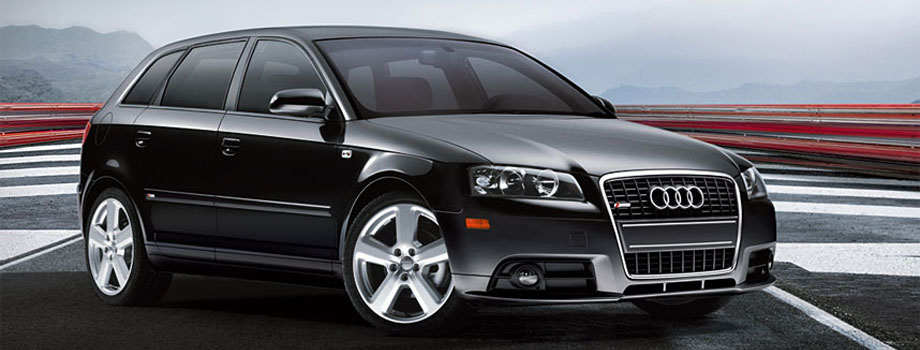Third generation version of exceptionally successful five-door A3 debuts at French show with more style and more room thanks to longer wheelbase
• Five-door A3 is now open for ordering – £620 premium over three-door – launch model prices from £19,825 OTR
• More functional than ever with wheelbase 58mm longer than predecessor and 35mm longer than new three-door – 1,220 litres of luggage capacity
• Audi ultra lightweight construction and advanced engine technology for low CO2 emissions
• Driver assistance systems from the full-size class
The latest Audi A3 appears in a new capacity at next week’s Paris Motor Show (September 29 to October 14) as the third generation five-door Sportback version makes its world public debut.
By combining its sleek new look with a longer wheelbase than both its predecessor and its all-new three-door counterpart, the eminently practical compact is able to offer even more space for families and their luggage, with barely any increase in exterior ‘footprint’. Carrying a premium of £620 over its three-door equivalent, the first phase of A3 Sportback models is now open for ordering priced from £19,825 OTR.
Exterior design
The new Audi A3 Sportback is long and lean. While the length (4,310 millimetres), width (1,780 millimetres) and height (1,425 millimetres) are only slightly greater than in the previous model, the wheelbase now measures 2,636 millimetres, an increase of 58 millimetres. This makes the five-door model 35 millimetres longer between the axles than the three-door version.
The design with the three side windows is taut and concentrated. The distinguishing element at the front of the A3 Sportback is the distinctive, stone grey single-frame grille with its angled upper corners. The lower edges of the headlights taper off at an angle, and in S line models are equipped as standard with xenon plus headlights with LED daytime running lights – these will also be optional for other versions. Large air intakes up front hint at the power of the engines.
The sharply defined tornado line articulates the flank below the windows and evokes a powerful shoulder. The dynamic line above the side sills runs upwards toward the rear.
The tautly curved surfaces, the large, precisely defined wheel wells, the relatively narrow, sharply sloping C pillars and the understated roof spoiler lend the A3 Sportback a dynamic air, as do the exterior mirrors, which in common with many sports cars are perched on the doors.
At the rear, the split rear lights underscore the width of the A3 Sportback – in S line models, or where the optional LED light package has been specified, these are formed using LEDs whose conductors appear to form a continuous arch. The adaptive brake light, which pulses at high frequency during hard braking, is standard. A sharp crease sets off the diffuser, and depending on the engine the exhaust system which protrudes from it terminates in one or two tailpipes on the left side of the car.
Ultra lightweight body
The Audi ultra lightweight design principle has long been a cornerstone for the brand. It reduces the weight of the new A3 Sportback by as much as 90 kilograms compared with the previous version. Equipped with the 1.4 TFSI engine, the five-door model has a kerb weight (without driver) of just 1,205 kilograms – a reversal of the weight spiral which makes the Sportback a class-leader in this respect.
High-end components of hot-shaped steel in the occupant cell form a strong, yet lightweight structure. They comprise a large portion of the body and are a major factor behind the weight savings of 37 kilograms in the occupant cell. High and ultra-high-strength steels are used in many other areas. The bonnet, the wings, the profile behind the front bumper and the front axle subframe are made of aluminium. Together they save roughly 12 kilograms and thus improve axle load distribution.
The body of the Audi A3 Sportback is extremely stiff and quiet, as components such as a noise-insulating windscreen reduce interior noise levels. Thanks to extensive fine-tuning that also included the engine compartment and the underbody, the coefficient of drag is just 0.30. Passive safety is also top-notch. In the event of a collision with a pedestrian, a pyrotechnic element at the back of the bonnet raises it several centimetres to cushion the impact.
Interior
The interior of the new A3 Sportback is marked by an elegant, clean and light design. A long arch runs below the windscreen reminiscent of the larger Audi models. The instrument panel with its curved front is lean and low.
The intuitively clean ergonomics are a classic Audi strength, and are characterised by the MMI operating system with its power-retractable monitor which will be standard in UK models. Its terminal is located on the console of the centre tunnel, which is flanked by high knee pads. A button for the electromechanical parking brake replaces the handbrake lever – another adoption from the larger Audi models.
The driver sits at an elegant steering wheel which, depending on version, has three or four spokes, a flat-bottomed rim, multifunction buttons and shift paddles. The large dial instruments can be easily read at a glance. The newly developed front seats offer outstanding support, and sports seats are fitted as standard to Sport and S line versions
Thanks to the 58 millimetre increase in wheelbase length, the A3 Sportback offers ample rear seat space and easy access for three adults. It also offers several millimetres more head and leg room than its predecessor.
The interior of the new A3 Sportback conveys the luxurious look and feel of the full-size class. The sculpted inlays are just one of its highlights. Depending on version these have a Micrometallic Silver, Aluminium Mistral or matt brushed aluminium finish. An optional 3D ‘Optic’ look inlay manufactured in a complex process to produce a glass-like appearance which gives it intense depth is available as an option.
The four large, round air nozzles in a jet design are additional examples of the aesthetics of technology. The stream of air can be adjusted between a diffuser setting and a targeted flow by tapping and pulling on the central hub of the nozzle.
The control unit for the dual-zone air conditioning which will be fitted as standard to Sport and S line versions and optional for SE models is mounted on a black, piano-finish fascia. The instrument cluster fascia is also black. Many control elements are available in an aluminium-look finish, and the optional interior lighting package includes subtle LED lights.
Cloth seats are standard for SE and Sport models, while S line versions upgrade to a mixture of Biathlon cloth and leather. Options include Milano leather or a combination of leather and Alcantara. The Milano leather sport seats are covered with soft Velvet in the shoulder region.
Equipment levels mirror the three-door A3 across the three SE, Sport and S line specification levels, but the more family-oriented Sportback also adds rear electric windows and rear door child locks in each case. Highlights common to all also include alloy wheels, air conditioning (manual in the SE, dual zone with electronic control in Sport and Sline), the acclaimed MMI radio with its 11 millimetre-thin electrically folding screen, preparation for SD card navigation, Audi Music Interface iPod connection, a Driver Information System, the Bluetooth mobile phone interface with voice control and a multi-function steering wheel.
Sport models upgrade to larger alloy wheels and incorporate the Audi drive select adaptive dynamics system which enables the driver to choose from five modes dictating the car’s driving characteristics – Comfort, Auto, Dynamic, Efficiency and Individual. They influence the weighting of the steering, the sensitivity of the throttle pedal, the shift points of the S tronic transmission if this is fitted and the parameters used by the optional adaptive cruise control system. Additional Sport features also include sports seats, sports steering wheel and additional aluminium detailing inside and out.
Stand-out features of the top S line specification include 18-inch alloy wheels, S line body styling, xenon headlights with LED daytime running lamps, an S line sports steering wheel and part-leather-upholstered sports seats embossed with the S line logo.
The luggage compartment offers 380 litres of space in the basic configuration, 10 litres more than its predecessor. This expands to 1,220 litres with the seats folded down. The cargo floor is flat and the opening between the wheel wells measures 100 centimetres. The floor can be inserted on two levels, and the supports on which it rests are marked with small LED lights. The rear seat can be folded down in a 60:40 split or as a whole. Hooks for bags and tie-down rings are standard. Options include a reversible mat, a storage and luggage compartment package and a through-load facility for lengthier items such as skis and snowboards.
Engines
Audi will initially offer the new A3 Sportback with a choice of one TDI and two TFSI engines. Two diesel engines and one petrol unit will follow later. They combine multiple efficiency technologies – direct injection, turbocharging, innovative thermal management and the start-stop system. Fuel consumption has been reduced on average by around 10 per cent compared with the previous model.
The newly developed 2.0 TDI, with balancer shafts that now rotate in the crankcase, will in the longer term be available in two versions. The first to arrive will be the 150PS version familiar from the three-door, which produces 320 Nm of torque and enables the front-wheel-drive A3 Sportback 2.0 TDI to reach 62mph from rest in 8.4 seconds and continue to a top speed of 133mph. Combined fuel economy for this version is 67.3mpg, corresponding to CO2 emissions of 108 g/km.
The more powerful version which will follow later will offer 184PS and 380 Nm of torque. The key data (with manual transmission and front-wheel drive): zero to 62mph in 7.4 seconds, top speed of 144mph and combined fuel economy of 65.7mpg.
The 1.6-litre TDI which has just become available for the three-door version will also follow later in 2012. The outstandingly efficient compact diesel, which is characterized by minimal internal friction, can deliver up to 74.3mpg when paired with the manual transmission, corresponding to CO2 emissions of 99 g/km. It powers the Audi A3 Sportback from zero to 62mph in 10.9 seconds on its way to a top speed of 121mph.
The new 1.4 TFSI will initially be the smallest petrol engine in the A3 Sportback range. Now featuring an aluminium block, and weighing just 107 kilograms – 21 kilograms less than its predecessor – it produces 122PS and 200 Nm of torque, accelerating the A3 Sportback from zero to 62mph in 9.3 seconds on its way to a top speed of 126mph. Combined economy is 53.3mpg, which corresponds to 123 grams of CO2/km.
A second version of the 1.4 TFSI offering 140PS and 250 Nm of torque will follow. It features the innovative cylinder on demand (COD) system, which deactivates the second and third cylinders at low to intermediate loads and while coasting.
The powerful 1.4-litre engine’s combined economy is 60.1mpg. Performance is brisk, with a time of 8.4 seconds for the standard sprint (with manual transmission) and a top speed of 132mph.
The new 1.8 TFSI, the most powerful petrol engine in the range, is next in the line-up at launch. It produces 180PS and 250 Nm of torque, and combines FSI direct injection with indirect injection and the Audi valvelift system to vary valve lift as required. The exhaust manifold is integrated into the cylinder head – a similar solution is also used in the two smaller TFSI engines. Key performance data with
S tronic and front-wheel drive: from zero to 62mph in 7.3 seconds, top speed of 144mph and combined economy of 50.4mpg corresponding to 130 g/km.
Later in 2012 the 1.2 TFSI, which also features an aluminium crankcase designed for low weight and minimal friction, will join the range. It produces 105PS and 175 Nm of torque. Together with S tronic transmission, it will power the A3 Sportback from zero to 62mph in 10.7 seconds and on to a top speed of 120mph. Combined fuel economy is 57.6mpg.
Audi will quickly expand the range of engines for the A3 Sportback to include a dynamic S model and additional high-efficiency, low-emissions variants.
Power transmission
The majority of engines in the new Audi A3 Sportback are paired with a manual six-speed gearbox, with the exception of the 1.8 TFSI which in the UK will initially be equipped exclusively with S tronic transmission. S tronic will be available as an option for all other engines. Depending on the version, the dual-clutch transmission shifts extremely quickly and nearly imperceptibly through six or seven gears.
The driver can operate S tronic via the selector lever or with the optional paddles on the steering wheel. Revs are somewhat higher in the automatic S mode, whereas D mode prioritizes taller gear ratios. When combined with Audi drive select (standard in the A3 Sport and above), S tronic includes a free-wheeling function in efficiency mode that further reduces fuel consumption.
With engines producing up to 180PS, the power is delivered to the front wheels, but quattro permanent all-wheel drive featuring a newly developed multi-plate clutch will become available as an option for the 1.8 TFSI and 2.0 TDI in the future.
The hydraulically actuated and electronically controlled component, which can send the power from the front to the rear axle in just a few milliseconds, weighs significantly less than the previous unit.
Chassis
The chassis of the new Audi A3 Sportback offers great composure and stability thanks to the finely balanced distribution of axle loads. The front axle has been shifted forward by 40 millimetres compared with the previous model, shortening the overhang correspondingly. All of the engines are installed tilted backward by
12 degrees with the exhaust end facing the bulkhead. This concept is an element of the modular transverse platform (MQB).
The front axle of the Audi A3 Sportback is a McPherson construction with wishbones and lightweight aluminium pivot bearings. It is mounted on an aluminum subframe. Mounted on a steel subframe, the four-link rear suspension handles longitudinal and transverse forces independently. The springs and dampers are mounted separately. The two sports suspensions available lower the body by 15 or 25 millimetres respectively.
Suspension grades across the three specification levels will be more interchangeable than ever before in the latest A3 Sportback. As standard, SE models will feature more comfort-oriented standard suspension, while Sport and S line versions will move to a firmer sport setting which in S line models can be taken to an even more overtly handling-focused level with the no-cost option of dedicated S line sports suspension. A3 Sport and S line customers will also, however, have the option to take the opposite approach by combining the attractions of Sport and S line specification with the optimum comfort of standard suspension.
The electromechanical power steering with a direct steering ratio of 15.3:1 is sensitive and highly efficient. Its drive unit consumes no energy while driving straight ahead – a key contribution to overall efficiency. The steering works closely together with a variety of assistance systems, including Audi active lane assist and the parking assistant. The turning circle measures just 10.9 metres.
Powerful brakes provide the stopping power; the front discs are internally vented. The ESC electronic stabilization control includes the electronic limited slip differential, which helps the driver when cornering. If a wheel on one of the axles spins, the electronic limited slip differential brakes it slightly, causing the car to turn slightly into the corner. The electromechanical parking brake can be supplemented with a hill hold assist function.
Infotainment
The new Audi A3 Sportback presents a groundbreaking innovation in mobile communications electronics – the modular infotainment platform (MIB). The concept behind it enables very fast innovation cycles in development.
The central computer of the new MMI includes the MMX board (MMX: Multi-Media eXtension). One of the plug-in module’s key components is the fast T-20 graphics process from market leader Nvidia’s Tegra 2 series. The chip, which generates complex 3D images, is used in all online, voice control, media, navigation and telephone functions.
The high-resolution monitor of the MMI operating system measures either 5.8 or
7 inches in diagonal and extends automatically from the instrument panel.
Just 11 millimeters (0.43 in) thick, its lightweight magnesium housing is finished in high-gloss black for an elegant, premium appearance.
Audi is also presenting important innovations for the control terminal on the centre tunnel console. The permanent rocker switches – the hard keys – for navigation, telephone, radio and media have been rearranged. With the top-of-the-line MMI navigation plus, the large rotary pushbutton with MMI touch – a solution from Audi’s full-size models – has been consolidated into a touch wheel. The touch-sensitive field, on which drivers can enter letters and numbers with their fingers, forms the surface of the control wheel.
The standard MMI system can be upgraded to MMI navigation plus with MMI touch – a media centre with 10 GB of music storage capacity and a DVD drive. The high-resolution 7-inch monitor displays the map with detailed 3D graphics. Mobile phones and players can be paired with MMI navigation plus through the integrated Bluetooth interface.
A number of attractive modules round out the range, including a module for digital audio broadcasting and the Audi Phone Box for easily connecting mobile phones to the vehicle antenna. The optional Bang & Olufsen sound system, whose 705-watt, 5.1-channel amplifier drives 14 speakers, is available in addition to the Audi Sound System. LED light guides illuminate the fames of the woofers in the front doors.
Driver assistance systems
The new Audi A3 Sportback also uses advanced technologies for the driver assistance systems. The most important of these is Audi adaptive cruise control. At speeds up to 93mph, the radar-based cruise control keeps the car at an interval defined by the driver from the car ahead. With the driver assistance package, which combines multiple systems, the system is active at speeds up to 124mph. In combination with S tronic, ACC offers a stop & go function for low speeds.
Additional systems round out the lineup. Audi side assist monitors lane changes with rear-facing radar, and Audi active lane assist helps drivers remain in their lane by slightly correcting the electromechanical steering, if necessary. The latter system’s video camera is also used for the traffic sign recognition system, which displays speed limits and other signs. The driver information system with rest recommendation detects when the driver is getting tired and issues a warning.
Several systems are available to make parking easier; the top of the line is the park assist system with 360° display. It takes over steering from the driver when parking in both parallel and perpendicular spaces, manoeuvring multiple times, if necessary. Its twelve ultrasonic sensors detect obstacles all round the vehicle. The park assist system can be supplemented with a reversing camera.
Another high-end option is the safety system Audi pre sense basic. If the
A3 Sportback begins to skid, it tenses the front seat belts electrically, and the windows and sunroof begin to close. The additional function pre sense front is integrated into the adaptive cruise control. In the event of a pending rear-end collision with the vehicle ahead, it warns the driver in stages and initiates precise and partial braking, if necessary.
At speeds below 19mph, Audi pre sense front (which is included with the optional Adaptive cruise control) brakes the A3 Sportback in an emergency with nearly full power. If a collision occurs, a new subsystem is activated: the multicollision brake assistant. It ensures that the vehicle does not continue to roll uncontrolled.
The new Audi A3 Sportback is available to order now, and the first cars will reach customers here in March 2013.





[…] New A3 Sportback In Paris is a post from: Auto n Spire […]